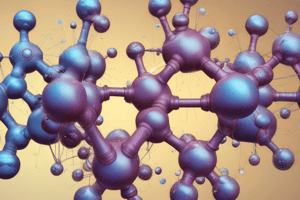Podcast
Questions and Answers
What is a characteristic of acids?
What is a characteristic of acids?
- Feel slippery to the touch
- Bitter taste
- Sour taste (correct)
- Neutral in taste
What is the pH range of acidic solutions?
What is the pH range of acidic solutions?
- pH = 7
- pH = 0
- pH < 7 (correct)
- pH > 7
Which of the following is a strong acid?
Which of the following is a strong acid?
- CH3COOH
- NH3
- HCl (correct)
- H2CO3
What is the definition of a base?
What is the definition of a base?
What is the pH of a neutral solution?
What is the pH of a neutral solution?
Which of the following is a weak base?
Which of the following is a weak base?
What is the importance of acid-base chemistry in biological systems?
What is the importance of acid-base chemistry in biological systems?
What is formed by the reaction of an acid and a base?
What is formed by the reaction of an acid and a base?
Flashcards are hidden until you start studying
Study Notes
Acids
- Definition: A substance that donates a proton (H+ ion) in a solution
- Characteristics:
- Sour taste
- Conduct electricity
- Turn litmus paper red
- React with metals to produce hydrogen gas
- Examples:
- Hydrochloric acid (HCl)
- Sulfuric acid (H2SO4)
- Nitric acid (HNO3)
- Acetic acid (CH3COOH)
Bases
- Definition: A substance that accepts a proton (H+ ion) in a solution
- Characteristics:
- Bitter taste
- Feel slippery to the touch
- Conduct electricity
- Turn litmus paper blue
- React with oils to produce soap
- Examples:
- Sodium hydroxide (NaOH)
- Calcium hydroxide (Ca(OH)2)
- Ammonia (NH3)
pH Scale
- Measures the concentration of hydrogen ions (H+) in a solution
- pH = -log[H+]
- Range: 0-14
- Acidic: pH < 7
- Neutral: pH = 7
- Basic: pH > 7
Salt
- Definition: A substance formed by the reaction of an acid and a base
- Characteristics:
- Neutral in taste
- Neither acidic nor basic
- Formed by the reaction of an acid and a base
- Examples:
- Sodium chloride (NaCl) - formed by the reaction of HCl and NaOH
- Calcium carbonate (CaCO3) - formed by the reaction of H2CO3 and Ca(OH)2
Strong and Weak Acids and Bases
- Strong acids:
- Completely dissociate in water
- Examples: HCl, H2SO4, HNO3
- Weak acids:
- Partially dissociate in water
- Examples: CH3COOH, H2CO3
- Strong bases:
- Completely dissociate in water
- Examples: NaOH, Ca(OH)2
- Weak bases:
- Partially dissociate in water
- Examples: NH3, trimethylamine (N(CH3)3)
Importance of Acid-Base Chemistry
- Biological systems: pH affects enzyme activity, protein structure, and cell function
- Environmental systems: pH affects soil chemistry, water quality, and ecosystem health
- Industrial applications: pH control is crucial in manufacturing processes, such as food processing and pharmaceutical production
Acids
- Donate a proton (H+ ion) in a solution
- Typically have a sour taste
- Conduct electricity and turn litmus paper red
- React with metals to produce hydrogen gas
- Examples include hydrochloric acid (HCl), sulfuric acid (H2SO4), nitric acid (HNO3), and acetic acid (CH3COOH)
Bases
- Accept a proton (H+ ion) in a solution
- Typically have a bitter taste and feel slippery to the touch
- Conduct electricity and turn litmus paper blue
- React with oils to produce soap
- Examples include sodium hydroxide (NaOH), calcium hydroxide (Ca(OH)2), and ammonia (NH3)
pH Scale
- Measures the concentration of hydrogen ions (H+) in a solution
- pH is calculated using the formula pH = -log[H+]
- Ranges from 0 to 14, with 7 being neutral
- Acidic solutions have a pH below 7, while basic solutions have a pH above 7
Salts
- Formed by the reaction of an acid and a base
- Neutral in taste and neither acidic nor basic
- Examples include sodium chloride (NaCl) and calcium carbonate (CaCO3)
Strong and Weak Acids and Bases
- Strong acids completely dissociate in water, releasing all H+ ions
- Examples of strong acids include hydrochloric acid (HCl), sulfuric acid (H2SO4), and nitric acid (HNO3)
- Weak acids partially dissociate in water, releasing some H+ ions
- Examples of weak acids include acetic acid (CH3COOH) and carbonic acid (H2CO3)
- Strong bases completely dissociate in water, releasing all OH- ions
- Examples of strong bases include sodium hydroxide (NaOH) and calcium hydroxide (Ca(OH)2)
- Weak bases partially dissociate in water, releasing some OH- ions
- Examples of weak bases include ammonia (NH3) and trimethylamine (N(CH3)3)
Importance of Acid-Base Chemistry
- pH affects enzyme activity, protein structure, and cell function in biological systems
- pH affects soil chemistry, water quality, and ecosystem health in environmental systems
- pH control is crucial in industrial applications, such as food processing and pharmaceutical production
Studying That Suits You
Use AI to generate personalized quizzes and flashcards to suit your learning preferences.




